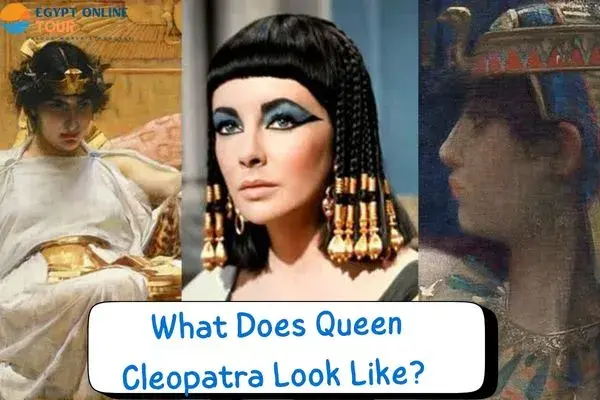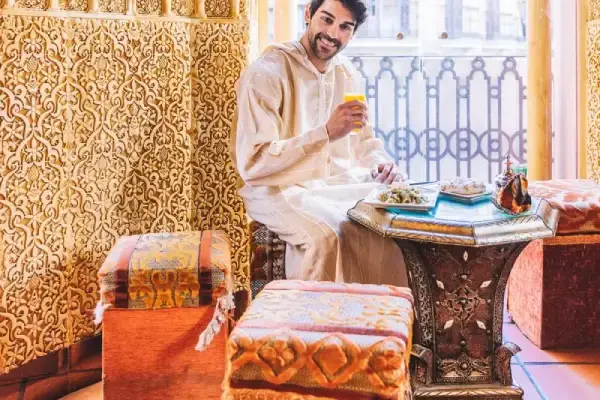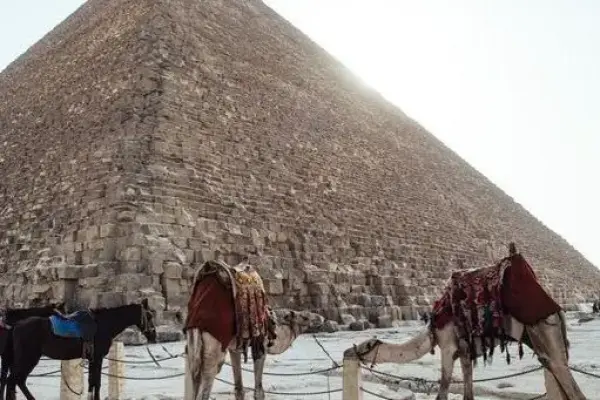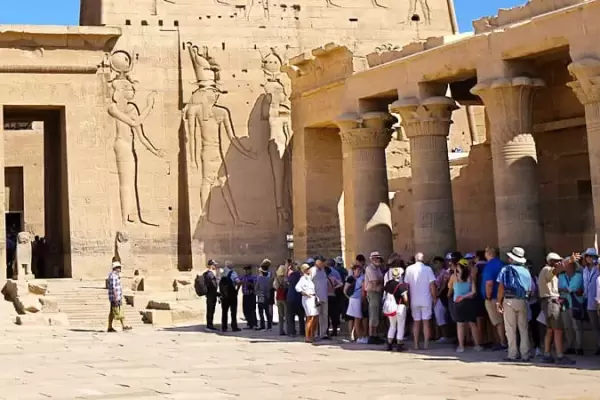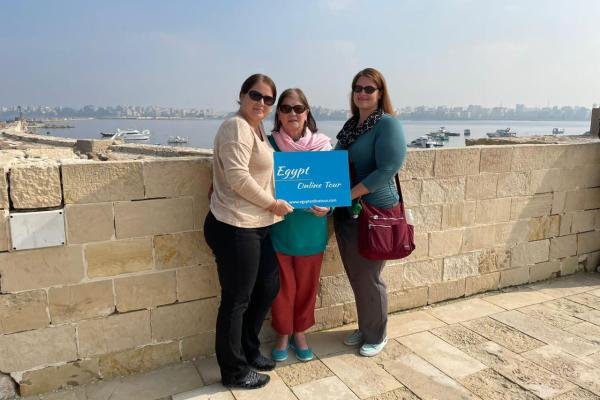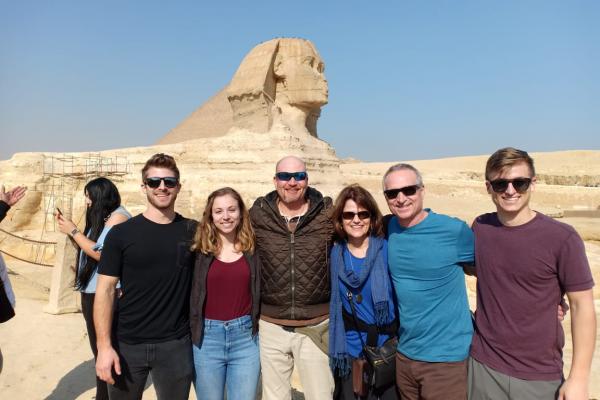If you’ve ever found yourself asking, "What does Queen Cleopatra look like?" then here you will find your answer. Cleopatra wasn’t just an ancient Egyptian queen; she was an icon of beauty, charm, and political power. In this article, we’ll take you through her story from birth to her final days, revealing all the secrets about her.
Table of contents [Show]
- Who Was Cleopatra?
- When Was Queen Cleopatra Born?
- What Was Cleopatra's Skin Color?
- Why Choose Egypt Online Tour for Your Next Adventure?
- How Old Was Cleopatra When She Became Queen?
- Who Did Queen Cleopatra Marry?
- What Was Cleopatra Famous For?
- How Did Cleopatra Die?
- How Old Was Cleopatra When She Died?
- When Did Queen Cleopatra Die?
Who Was Cleopatra?
Cleopatra is one of the most famous figures history loves to remember—not just because she was a queen, but because she was a smart, strong woman who not just anyone could handle.
Cleopatra VII Philopator was her full name, and she belonged to the Ptolemaic lineage—a Macedonian Greek royal family that took control of Egypt following the reign of Alexander the Great.
What makes Cleopatra really stand out is that she wasn’t your typical queen who just sits on the throne and wears a crown—no way!
She spoke several languages, including ancient Egyptian, and was skilled in politics and diplomacy, she knew how to deal with the most powerful men of her time, like Julius Caesar and Mark Antony.
So when we say “Who was Cleopatra?” simply put, she’s a symbol of beauty and intelligence, an unforgettable queen who left her mark on the history of Egypt and the entire world, and people still talk about her to this day.
Cleopatra VII Philopator – The Last Pharaoh
Cleopatra VII, officially called Cleopatra Philopator, was the last true Pharaoh to rule Egypt before it fell under Roman control. You could say she marked the end of a great era of the pharaohs.
Unlike many rulers before her, Cleopatra wasn’t just a queen on the throne; she was a political fighter who knew how to keep her throne amid storms all around her.
From a young age, she learned how to rule, excelling in math, philosophy, and languages—including ancient Egyptian, which previous Ptolemies didn’t bother to learn.
Cleopatra was trying hard to keep Egypt independent from the growing Roman Empire and protect her country, even if that meant allying with powerful figures like Caesar and Antony.
Today, many travelers exploring Egypt tour packages are fascinated by Cleopatra’s legacy—she wasn’t just a queen, she was the last spark of the Pharaonic civilization before Roman occupation.
Queen of Egypt and Political Powerhouse
Cleopatra wasn’t just a beautiful queen wearing a crown; she was a “shrewd politician” in every sense of the word, always ahead of her time.
From the moment she started ruling, she was thinking of plans not only to keep her throne but also to protect all of Egypt from Roman greed that was growing bigger by the day.
People often saw her relationships with Julius Caesar and Mark Antony as love stories, but the truth is, she calculated every move. Cleopatra understood that being close to powerful men like them would give her a chance to prove herself and maintain Egypt’s strength.
She truly made herself a partner in global politics—not just a wife or lover. She knew how to talk, persuade, and strategize, and anyone who sat with her felt they were facing a woman not easy to deal with.
If you’re interested in visiting the places where she lived and seeing the relics from her time, you can explore many Egypt Classic Tours that offer a full historical experience.
When Was Queen Cleopatra Born?
Around 69 BC, Cleopatra came into the world in Alexandria—a vibrant Egyptian city that stood at the forefront of learning, culture, and innovation during that era.
Alexandria was a special city, built in the Greek style, full of libraries and centers of learning.
Her childhood was very different from other kids’ because she was raised with the idea that she had to be not just a queen, but a smart and strong leader.
She didn’t just learn games or simple things—she studied many languages, math, and philosophy to prepare herself to rule Egypt.
Her Early Years in Alexandria
Cleopatra spent her early years in Alexandria, which was very different from anywhere else in Egypt. It was full of knowledge and arts, which shaped her personality a lot.
From a very young age, she learned multiple languages like Greek, Coptic, and even ancient Egyptian—something uncommon among Ptolemaic rulers who came from outside Egypt.
She was also surrounded by teachers and philosophers who helped her understand how to rule a big country like Egypt, making her not just beautiful but politically mature.
She loved reading and learning about history and politics, which helped her rule Egypt wisely and strongly when the time came.
What does Queen Cleopatra Look Like?
One of the most asked questions about ancient Egypt is: what does Queen Cleopatra look like? Was she really as beautiful as the movies say? The truth is, there’s no confirmed painting or sculpture that shows her real face, but we do have some clues.
Ancient coins, statues, and writings give us bits and pieces to build a picture. Some say she had sharp features, a strong nose, and clever eyes. But here’s the thing—most historians agree her true charm wasn’t just in how she looked, but in her presence.
She was highly educated, spoke many languages, and had the charisma to influence powerful men like Julius Caesar and Mark Antony.
So if you're imagining a Hollywood-style beauty, remember Cleopatra’s real power came from her mind, voice, and magnetic personality—not just her looks.
If you’re interested in visiting the places connected to her life and death, Luxury Egypt Tours give you the chance to explore the history and see the relics up close.
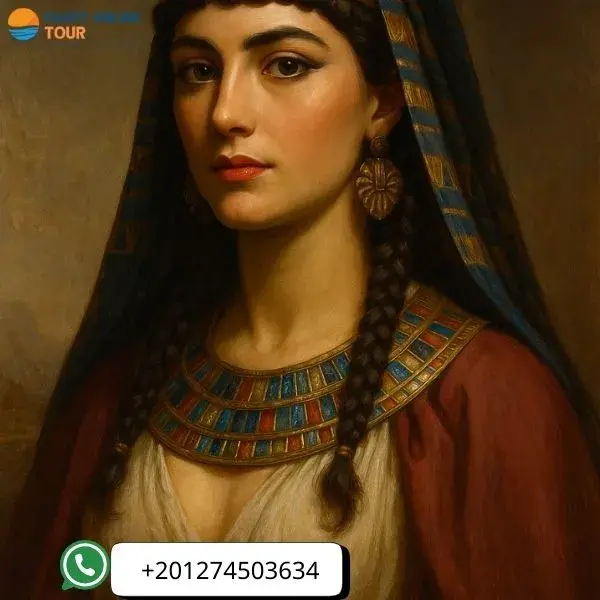
Cleopatra’s Description in Ancient Sources
When we look into ancient texts like those by Plutarch, we find that Cleopatra wasn’t described as the most beautiful woman in the world.
Plutarch said her beauty "wasn't incomparable," but her voice, personality, and intelligence made her incredibly attractive. She had a charming way of speaking and a captivating presence. This makes the question what does Queen Cleopatra look like deeper than just physical features.
Another Roman writer, Cassius Dio, mentioned her “exquisite beauty,” but again, without many physical details.
What we can learn from this is that Cleopatra's beauty wasn’t just about her face, it was about how she carried herself, how she communicated, and the aura she gave off.
In many ways, her looks were just one part of a much bigger story of a woman who ruled, negotiated, and inspired with both brains and charisma.
Cleopatra in Roman Propaganda
It’s important to remember that a lot of what we know about Cleopatra comes from Roman sources, and they were her enemies, especially Octavian (later Augustus), who led a campaign to paint her as a dangerous Eastern temptress who seduced Mark Antony and brought trouble to Rome.
This was more than gossip, it was political propaganda. So when we read Roman descriptions of her appearance, we have to take them with a grain of salt, they might not be accurate, just dramatic.
Some said she was manipulative, others said she used her beauty as a weapon. But all of this shows just how powerful and intimidating she was in their eyes.
The image of her being dangerously beautiful might have been exaggerated to justify going to war with her.
Cleopatra in Modern Media
Hollywood has played a huge role in shaping how we imagine Cleopatra today. Most famously, Elizabeth Taylor’s 1963 film gave us a stunning, glamorous Cleopatra—draped in gold, with bold eyeliner and flawless hair.
Recently, Netflix’s "Queen Cleopatra" sparked debate by portraying her with African features, leading to controversy over her ethnic background.
Was she Greek? Was she African? The show tried to challenge old stereotypes, but it also reminded everyone how little we really know for sure.
The debate continues, and the question remains: what does Queen Cleopatra look like? What’s certain is that her appearance has been reinterpreted again and again—shaped by culture, politics, and imagination.
What Egyptian Artifacts Say About Her Looks
To get closer to the truth, we turn to the most reliable source—Egyptian artifacts.
Statues believed to represent Cleopatra, like the one in the Vatican Museum, show her with soft features and a traditional hairstyle called the “melon” style, tied into a bun with a royal crown. These sculptures show more dignity than glamor.
Coins minted during her reign also give clues—prominent nose, strong chin, and a commanding expression. These might not reflect pure beauty, but they definitely reflect power.
There’s even a small marble head found in the temple of Taposiris Magna near Alexandria that some believe could be Cleopatra. Others argue it’s not her. But all these clues bring us a little closer to answering that big question: what does Queen Cleopatra look like?
Let our local travel experts help you design the perfect itinerary. Whether you're seeking adventure, culture, or relaxation, we've got you covered!
What Was Cleopatra's Skin Color?
The question of Cleopatra’s skin color has caused a lot of debate, and it still does today.
Some people think she must have been very light-skinned because of her Greek ancestry, while others believe she might’ve had darker or even brown skin since she was born and raised in Egypt, surrounded by Egyptians.
The truth is, Cleopatra belonged to the Ptolemaic dynasty, a Greek family that ruled Egypt after Alexander the Great. So it’s natural to assume her skin tone leaned more toward fair.
But let’s be honest, no one knows for sure; no clear paintings or portraits of her survive from her lifetime. Most statues and coins made in her image were symbolic more than realistic.
What we do know is that Cleopatra stood out because of her strong presence and unique personality. Whether her skin was light or dark, she was a queen and a legend in every sense of the word.
Was Queen Cleopatra Black?
This question pops up all the time: Was Cleopatra Black? It’s understandable—Egypt is in Africa, and people often associate ancient Egyptians with African heritage.
But the story is more complex. Cleopatra was from the Ptolemaic dynasty, a Greek family that ruled Egypt and often married within their own bloodline to keep their ancestry pure, that means she likely had Greek features and was not of sub-Saharan African descent.
Some theories suggest that there could’ve been Egyptian or African roots mixed in, but there’s no solid historical proof to confirm that. The challenge is that no direct, confirmed physical descriptions of her exist—so people tend to fill in the blanks.
But really, her skin color isn’t the most important part of her story, what matters is her power, intelligence, and influence. she wasn’t just known for how she looked—she made history through her choices, her charm, and her strategic mind.
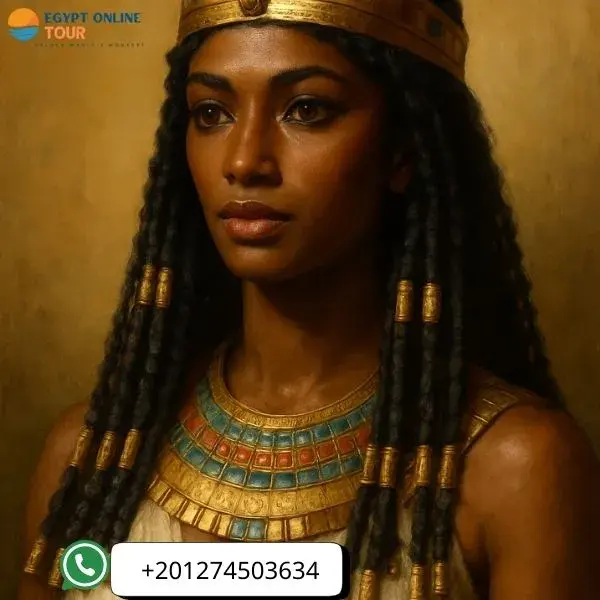
Was Cleopatra’s Beauty a Myth?
Many people imagine Cleopatra as “the most beautiful woman in the world.” But the truth might surprise you. Historians like Plutarch wrote that her beauty wasn’t unmatched, but her voice, charm, and personality were what made her truly attractive.
She had a way of speaking that drew people in, and she knew exactly how to carry herself.
She was highly educated, fluent in several languages, and confident in every room she walked into, that’s why Julius Caesar and Mark Antony weren’t just drawn to her looks—they were captivated by her intelligence and presence.
So, was Cleopatra’s beauty a myth? Maybe, but her impact, charisma, and legacy were very real, her beauty wasn’t just about her face, it was the way she made people feel, and the power she held in a world dominated by men.

If you're planning a special trip around Egypt or dreaming of an unforgettable adventure full of ancient wonders and stunning scenery, then Egypt Online Tour is exactly what you need!
We’ve got something for everyone, from exciting day tours in Cairo, Alexandria, Sharm El Sheikh, Hurghada, Luxor, and Aswan, to full vacation packages that suit all styles and budgets—whether you're after classic tours, luxury experiences, romantic honeymoon packages, budget-friendly options, or even spiritual and meditation retreats!
We also offer seamless shore excursions from Safaga, Sokhna, Port Said, Alexandria, and Sharm El Sheikh ports—perfect for cruise travelers who want to explore Egypt the right way.
And if you're planning something special like Christmas, Easter, New Year, or the Solar Eclipse 2027, we’ve got tailor-made tours just for that!
Why choose us?
- Friendly, multilingual guides
- Flexible itineraries that fit your time and mood
- Competitive prices with top-tier service
- Comfortable trips packed with amazing experiences
- Quick and easy communication anytime
Got a question or ready to book? Reach us at:
📧 [email protected]
📞 +201274503634
We're based in Nasr City, Cairo, Your unforgettable Egypt journey starts right here with us!
Let our local travel experts help you design the perfect itinerary. Whether you're seeking adventure, culture, or relaxation, we've got you covered!
How Old Was Cleopatra When She Became Queen?
Cleopatra was only about 18 years old when she became queen! You might imagine someone so young sitting on the throne, but back then, it was common for rulers to start their reigns while still young.
Despite her age, Cleopatra was incredibly smart and had a clear vision to protect Egypt from the growing Roman power. She knew ruling wasn’t just about wearing the crown but also about making the right decisions and choosing the right allies.
At first, she ruled jointly with her younger brother Ptolemy XIII, but their relationship was tense, which pushed Cleopatra to fight hard to prove herself as the true queen of Egypt.
Who Did Queen Cleopatra Marry?
Cleopatra was super smart, not only in ruling Egypt but also in dealing with powerful people around her.
To protect her throne and keep Egypt safe from the growing power of Rome, she chose to marry or form alliances with influential Roman leaders. This helped her dive deeper into politics and maintain her kingdom’s independence.
Julius Caesar
The first important figure Cleopatra got involved with was Julius Caesar, the famous Roman general. Their relationship wasn’t just about love—it was a huge political alliance.
Caesar had enormous influence in Rome, and Cleopatra used that to strengthen her rule and keep Egypt independent as long as possible.
Their connection began when Cleopatra was fighting her brother for the throne, and Caesar supported her in this battle, which helped her secure her place as queen. During this time, they had a son named Caesarion, who symbolized the strong bond between Egypt and Rome.
If you want to visit the places where they met or see relics from their time, you can pick from the 15 Days Marvelous Tour Package in Egypt that lets you experience history firsthand.
Mark Antony
After Julius Caesar’s death, Cleopatra turned to Mark Antony, another top Roman leader. Their relationship was more than just politics—it was a legendary love story.
Mark Antony stood by Cleopatra as she struggled to keep Egypt’s throne amid the huge power struggles in Rome. Together, they formed a strong military and political alliance, planning a future that would protect Egypt’s interests against the expanding Roman Empire.
Their story became famous in movies and books, and today, travelers who choose the Luxury package in Egypt From USA love visiting the spots that witnessed their love and alliance, like Alexandria’s temples and Cleopatra’s palace.
What Was Cleopatra Famous For?
While Cleopatra's beauty is often highlighted, her brilliance and unmatched talent in politics and diplomacy truly set her apart as a legendary figure.
Many people talk about how beautiful she was, but the truth is her smarts kept her strong and able to rule Egypt during some really tough times.
She spoke many languages, understood different countries’ politics, and knew how to use her words and wisdom to form alliances and manage Egypt’s affairs the best way possible.
Cleopatra’s Intelligence and Diplomacy
One of the biggest things that set Cleopatra apart was her great intelligence and diplomatic skills. She was able to deal with some of the most powerful people of her time like Julius Caesar and Mark Antony, turning those relationships into political alliances to keep Egypt independent.
Not many queens could earn the respect of Roman leaders when Rome was such a powerful empire, but Cleopatra used her political talents wisely.
Her intelligence wasn’t just about politics, it was also about understanding people and negotiating well, which made her one of the most famous rulers in Egypt’s history.
Her Role in Roman Politics
Cleopatra played a huge role not only in ruling Egypt but also in Roman politics, which was full of constant struggles.
She got involved in wars and alliances among Roman leaders, especially when she teamed up with Julius Caesar and later with Mark Antony.
Her role wasn’t easy because she was trying to keep Egypt independent against the powerful Roman Empire, which made her a key player in major political events that changed the ancient world.
If you’re interested in learning more and visiting the places where these events happened, you can choose from the 5 Days Cairo Alexandria Tour that gives you a chance to explore Cleopatra’s temples and palaces and see where history was made.

How Did Cleopatra Die?
Cleopatra’s death has always been surrounded by mystery and many different stories trying to explain the real reason behind it. It’s not simple because there are various accounts and unclear events.
Cleopatra fought hard to keep her throne, but when Emperor Octavian (later Augustus) invaded Egypt, everything changed.
After her defeat in battle, she chose to end her life on her own terms rather than being captured or tortured.
Her death was not just the end of a queen’s life but also marked the end of the pharaonic era in Egypt.
Theories and Historical Records About Cleopatra’s Death
There are several theories explaining Cleopatra’s death, the most famous being that she committed suicide by the bite of an asp (Egyptian cobra), which was a symbol of royalty in ancient Egypt.
This theory isn’t fully confirmed but appears in old historical books and sources. Others say she died from poison or was assassinated due to political conspiracies in Rome.
Historians have offered many versions, but the harsh truth is there’s no definitive proof about how she died. Despite that, Cleopatra’s death story remains one of the most mysterious and fascinating, always making people eager to learn more about her history.
How Old Was Cleopatra When She Died?
Cleopatra died at around 39 years old. Even though she was still young, her life was full of huge challenges and heavy responsibilities.
Throughout her life, she fought hard to keep Egypt’s throne amid internal struggles and the expanding Roman Empire.
Although she didn’t live to an old age, her impact on Egypt and world history was massive.
When Cleopatra died, it wasn’t only the fall of a powerful queen—it was also the final chapter of the ancient pharaonic rule in Egypt.
Cleopatra’s Last Days in Alexandria
In her final days in Alexandria, Cleopatra lived in her palace amid great tension and fear.
After Octavian’s army invaded Egypt and defeated Mark Antony’s forces, the situation quickly worsened for her.
The city was filled with unrest, and people feared the uncertain future after her rule ended. Cleopatra tried to stay calm and composed but knew the end was near.
During those moments, she thought about her own fate and Egypt’s future and decided to leave life on her own terms, befitting her royal status.
Her death in the Alexandria palace made her story one of the most fascinating and mysterious in history.
When Did Queen Cleopatra Die?
Queen Cleopatra died in 30 BC, marking the end of her long and eventful reign. Her death followed a major battle between her forces and those of Emperor Octavian, who aimed to take control of Egypt.
After she died, Egypt’s governance completely changed as it became part of the Roman Empire.
Frequently Asked Questions
1 What did Cleopatra actually wear on her eyes? ▶
2 Who held the title of ancient Egypt’s most beautiful queen? ▶
3 What was Cleopatra’s go-to hairstyle? ▶
4 What lip color did Cleopatra wear? ▶
5 How did Cleopatra take care of her hair? ▶
6 Did Cleopatra dress like the goddess Isis? ▶
7 Was Cleopatra’s hair curly or straight? ▶
8 How tall was Queen Cleopatra? ▶
9 What eye color did Cleopatra have? ▶
10 What nickname did Cleopatra go by? ▶
Popular Categories
Related properties
Cairo, Aswan, and Luxor
-
Precio
$ 2,850
-
Tipo
Package
Cairo, Aswan, and Luxor
-
Precio
$ 1,850
-
Tipo
Package
